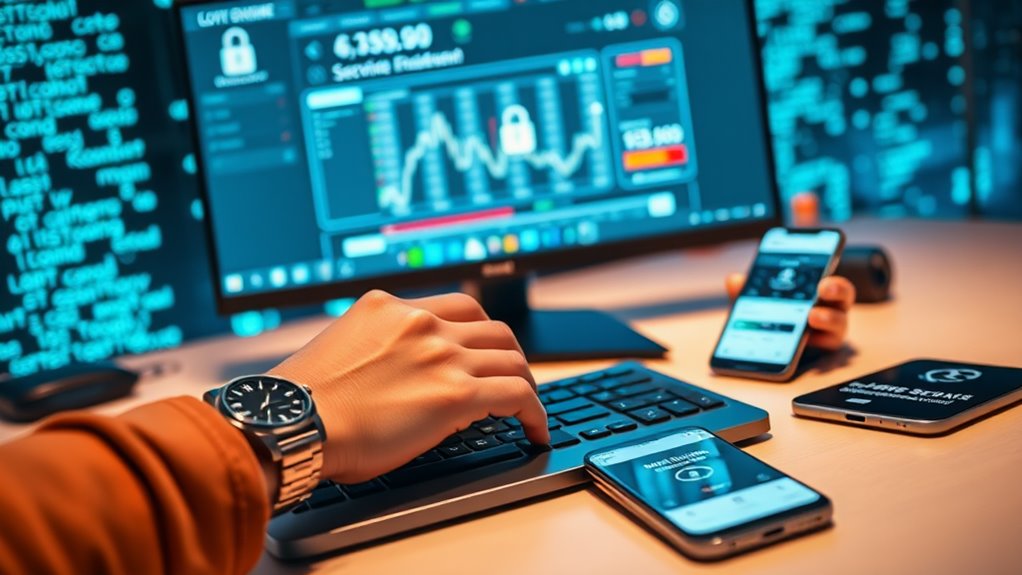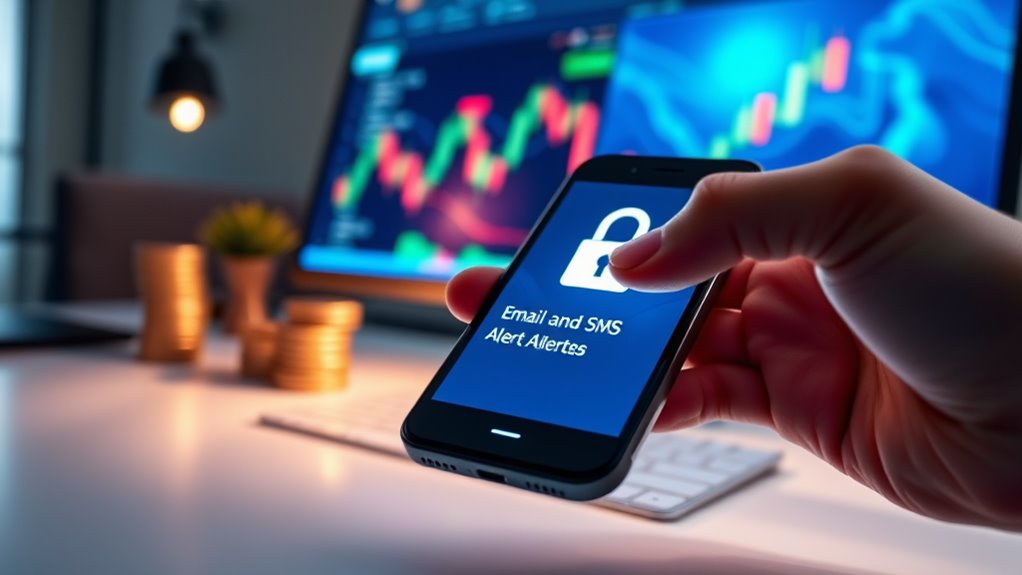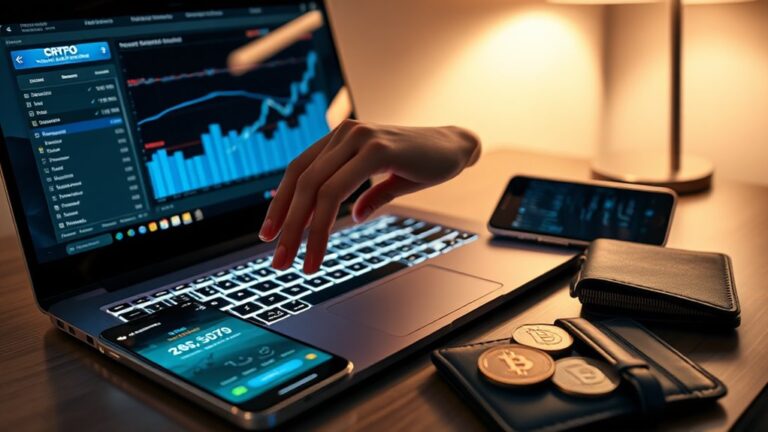
Crypto Exchange Security: 10 Essential Tips to Protect Your Assets
Protecting cryptocurrency assets requires multiple security layers. Investors should enable two-factor authentication, create strong unique passwords, and verify exchange security certifications before trading. Using hardware wallets for long-term storage, regularly auditing account activity, and setting up alerts for account changes add essential protection. Diversifying assets across multiple platforms, researching insurance policies, implementing IP restrictions, and maintaining cold storage further minimize risks. These strategies form an extensive defense against unauthorized access and potential theft.
Key Takeaways
- Enable two-factor authentication (2FA) using authenticator apps or hardware tokens rather than SMS for stronger security.
- Use strong, unique passwords for each exchange and consider a password manager to generate and store them.
- Distribute assets across multiple exchanges and wallets to minimize risk from security breaches.
- Invest in hardware wallets from reputable manufacturers for long-term storage of significant cryptocurrency holdings.
- Set up multi-channel alerts for account activities like logins, withdrawals, and password changes.
Enable Two-Factor Authentication (2FA) for Extra Protection

Securing cryptocurrency assets begins with implementing robust authentication methods. Two-Factor Authentication (2FA) adds an essential security layer beyond passwords by requiring secondary verification when accessing exchange accounts.
For cryptocurrency holders, this extra step is vital due to the irreversible nature of blockchain transactions.
Exchange platforms like Binance, Coinbase, and Kraken offer various 2FA options within their security settings. While SMS codes are common, they’re vulnerable to interception. More secure alternatives include mobile authenticator apps like Google Authenticator or hardware security tokens, which provide maximum protection for high-value portfolios.
When implementing 2FA, establish recovery procedures in case of device loss, maintain consistent protection across all platforms, and regularly update devices. Additionally, consider using hardware wallets to further enhance the security of your digital assets. These simple steps dramatically reduce the risk of unauthorized access, protecting your digital assets from potential theft.
Verify Exchange Security Certifications Before Trading

When choosing a cryptocurrency exchange, understanding security certifications represents a crucial step for protecting digital assets.
Respected certifications like CER, ISO 27001, and CCSS demonstrate an exchange’s commitment to robust security practices and compliance with international standards.
Traders should look for three key certification elements:
- Transparent security scores – Higher CER ratings (up to 3-star) indicate stronger cybersecurity measures and regular penetration testing.
- Public disclosure practices – Certified exchanges often publicly share wallet addresses and conduct regular fund audits.
- Bug bounty programs – These initiatives encourage ethical hackers to identify vulnerabilities before exploitation.
Choosing certified exchanges provides enhanced protection, increased transparency, and reduced risk for cryptocurrency investors. These certifications offer assurance that an exchange follows recognized security protocols designed to safeguard user funds and data, and they should also ensure compliance with regulatory standards that foster user trust.
Use Hardware Wallets for Long-Term Storage

While choosing exchanges with proper security certifications forms the first line of defense, the next step in safeguarding digital assets involves proper storage methods beyond exchange wallets.
Hardware wallets provide superior protection by keeping private keys offline, greatly reducing hacking risks.
When selecting a hardware wallet, prioritize devices from established manufacturers like Ledger or Trezor that feature secure element chips and physical verification methods.
During setup, carefully record and securely store the seed phrase, create a strong PIN, and only connect the device to trusted computers.
For ideal security, purchase wallets directly from manufacturers or authorized resellers to avoid tampering risks.
Regular firmware updates are essential to patch vulnerabilities.
With proper maintenance, hardware wallets can last 5-10 years, making them ideal for long-term cryptocurrency storage and protection against exchange-related security issues. Additionally, a crypto wallet acts as a key management tool for accessing digital assets on the blockchain, ensuring users can securely transact within the cryptocurrency ecosystem.
Create Strong, Unique Passwords for Each Exchange

The foundation of cryptocurrency exchange security rests on creating strong, unique passwords that serve as the first line of defense against unauthorized account access.
Strong, unique passwords form the essential foundation of crypto exchange security, protecting your digital assets from unauthorized access.
Password managers can generate and securely store complex combinations that hackers cannot easily crack, while eliminating the need to remember multiple credentials.
For maximum security, users should:
- Create passwords with a mix of uppercase and lowercase letters, numbers, and special characters
- Avoid using personal information or common phrases that could be guessed
- Never reuse passwords across different exchanges or platforms
Using different passwords for each exchange guarantees that if one account is compromised, others remain secure.
When combined with two-factor authentication, unique passwords greatly reduce the risk of unauthorized access to valuable cryptocurrency assets. Additionally, maintaining a secure internet connection helps protect against potential hacking attempts that could target your credentials.
Regularly Audit Your Account Activity and Transactions

Beyond strong password practices, cryptocurrency investors must develop a habit of regularly auditing their account activities and transactions. This proactive approach helps identify unauthorized access or suspicious transactions before they escalate into significant financial losses.
Investors should examine transaction patterns, noting any unusual activity in size, frequency, or destination addresses. Many exchanges provide transaction monitoring tools that generate alerts for suspicious activities. Reviewing these records at least weekly enables users to promptly report concerns to the exchange.
Additionally, implementing blockchain analytics tools can offer deeper insights into transaction histories. These audits not only protect personal assets but also contribute to the broader security ecosystem by flagging potentially fraudulent activities. Understanding the various tactics employed by hackers is essential for enhancing your security measures.
Consistent monitoring builds a baseline understanding of normal account behavior, making anomalies easier to detect and address promptly.
Understand Cold vs. Hot Storage Security Implications

Understanding the fundamental differences between cold and hot storage represents a critical knowledge area for cryptocurrency investors seeking optimal security.
Hot wallets remain connected to the internet, offering convenience for frequent transactions but exposing assets to greater cybersecurity risks. Conversely, cold wallets store private keys offline, dramatically reducing vulnerability to hacking attempts.
For ideal security management, investors should:
- Implement a combination strategy – use cold storage for long-term holdings and hot wallets only for active trading amounts
- Consider institutional-grade custody solutions like Bakkt or Gemini for substantial holdings
- Distribute assets across multiple wallet types to minimize concentration risk
Since 2022, over $7 billion has been stolen from cryptocurrency wallets, primarily through infrastructure attacks—highlighting why proper storage selection remains essential for asset protection. Additionally, selecting the right cryptocurrency wallet type can significantly enhance security by aligning with individual trading habits and risk tolerance.
Set Up Email and SMS Alerts for Account Changes

Setting up alerts for account changes creates a security system that immediately notifies users of potentially unauthorized activities on their crypto exchange accounts.
Implementing both email and SMS notifications guarantees users receive alerts through multiple channels, increasing the likelihood of timely detection even if one communication method is compromised.
Users can further enhance security by establishing custom notification thresholds that balance the need for awareness against alert fatigue, triggering notifications only for truly significant account activities. Additionally, users should consider the advantages of using a Centralized Exchange for better security features and customer support.
Immediate Compromise Detection
Detecting unauthorized access to crypto exchange accounts requires vigilant monitoring systems that alert users at the first sign of suspicious activity.
Effective detection combines automated tools with strategic security configurations to protect digital assets from potential threats.
Users should implement these essential detection measures:
- Configure immediate email and SMS notifications for account changes, including new login locations, password resets, and withdrawal attempts.
- Utilize transaction analysis tools that flag unusual patterns based on historical account activity.
- Enable user behavior tracking systems that identify anomalies in account usage, such as odd login times or unfamiliar IP addresses.
These proactive monitoring techniques allow crypto holders to respond quickly to potential security breaches, greatly reducing the risk of asset loss through unauthorized transactions. Additionally, staying informed about regulatory changes can enhance your understanding of the evolving security landscape in the crypto market.
Multi-Channel Alert System
Why rely on a single notification method when crypto threats can emerge from multiple vectors? Setting up multiple alert channels creates a thorough safety net for your crypto exchange accounts. By receiving notifications through email, SMS, Telegram, or other platforms, users can detect unauthorized activities promptly and respond swiftly. Implementing a robust KYC process enhances your security by verifying user identities and minimizing risks associated with financial crimes.
| Alert Type | Best Channel | Response Time | Security Level |
|---|---|---|---|
| Login Attempts | SMS/Push | Immediate | High |
| Password Changes | Email/SMS | 1-5 minutes | Critical |
| Transactions | Multiple | Immediate | Critical |
| Balance Changes | App/Email | Within hour | Medium |
For maximum protection, enable transaction alerts across multiple channels and customize them based on transaction size or type. This multi-layered approach greatly reduces response time to potential threats while ensuring you’re notified even when one communication channel is unavailable.
Custom Notification Thresholds
Fine-tuning your alert system creates a personalized security shield for crypto holdings. By establishing custom thresholds, users receive notifications only when genuinely necessary, preventing alert fatigue while maintaining vigilance over their assets.
Exchanges typically offer several customization options:
- Percentage-based alerts – Set notifications to trigger when asset values change by specific percentages (5%, 10%, or custom values)
- Transaction amount thresholds – Receive alerts only when transactions exceed predetermined amounts
- Login attempt notifications – Get informed whenever someone attempts to access your account
These customizable parameters enhance security while reducing stress. Users can select their preferred notification channels—email for detailed information, SMS for urgent matters, or push notifications for real-time updates.
Regular review and adjustment of these settings guarantees they remain effective as usage patterns change.
Diversify Assets Across Multiple Exchanges and Wallets

Traders who store all cryptocurrency holdings on a single exchange risk losing everything if that platform experiences a security breach or suddenly closes operations.
Distributing digital assets across multiple exchanges and wallets creates a safety net against catastrophic loss, as problems with one platform will only affect a portion of the total portfolio.
This strategy aligns with traditional investment wisdom of not keeping all eggs in one basket, particularly important in the cryptocurrency space where exchanges vary greatly in their security measures and regulatory compliance. Additionally, using both centralized and decentralized exchanges can optimize security and access to a broader range of trading options.
Reduce Single-Point Failures
Vulnerability in cryptocurrency management often stems from relying too heavily on a single exchange or wallet.
Spreading assets across multiple platforms creates redundancy that protects investors when one service experiences security breaches or operational failures.
To effectively reduce single-point failures:
- Distribute investments across 3-5 reputable exchanges, ensuring no single platform holds more than 30% of your total crypto assets.
- Utilize different wallet types including hardware wallets for long-term holdings, mobile wallets for transactions, and paper wallets for backup recovery phrases.
- Implement varied security measures for each wallet and exchange account, including unique passwords, different email addresses, and platform-specific two-factor authentication methods.
Regular security audits of your distribution strategy will help identify potential vulnerabilities before they can be exploited.
Minimize Exchange-Specific Risk
While distributing crypto assets across multiple platforms helps prevent single-point failures, a strategic approach to exchange and wallet selection adds another layer of protection.
Investors should consider factors such as regulatory compliance, cybersecurity measures, and liquidity access when choosing exchanges.
Combining both cold and hot wallets creates a balanced security approach—cold wallets for long-term storage and hot wallets for active trading. Multi-signature options add further protection by requiring multiple approvals for transactions.
Asset diversification should extend beyond platforms to include different crypto categories, such as DeFi tokens, NFTs, and coins with varying market capitalizations.
This approach reduces sector-specific vulnerabilities while maintaining exposure to growth opportunities. Regular security updates and strong authentication practices further strengthen this diversified ecosystem, making it considerably harder for attackers to compromise an entire portfolio.
Research Exchange Insurance Policies and Coverage

Because cryptocurrency markets operate in a largely unregulated space, understanding insurance policies becomes an essential component of exchange security.
When evaluating exchanges, investors should carefully research what protections are in place against potential losses from hacks, theft, or operational failures.
Key insurance considerations include:
- Coverage types – Determine whether the exchange offers protection for cybersecurity incidents, fraud, and operational disruptions.
- Policy limitations – Understand what isn’t covered, as most policies exclude market volatility losses and certain types of physical hardware damage.
- Claims process – Research how claims are handled and what documentation would be required in the event of a security breach.
Many reputable exchanges now maintain dedicated insurance funds like Binance’s SAFU to provide additional layers of protection beyond traditional insurance policies.
Implement IP Address Restrictions for Account Access

Implementing IP address restrictions adds a critical layer of security by limiting account access to specific, trusted locations through geographic controls.
Users can create a whitelist of approved IP addresses, ensuring that login attempts from unknown locations are automatically blocked.
These restrictions enforce authentication policies by preventing unauthorized access attempts, even if login credentials have been compromised through phishing or data breaches.
Geographic Access Controls
Effective account protection for cryptocurrency exchanges starts with robust geographic access controls. By limiting access to specific IP addresses and regions, exchanges greatly reduce unauthorized access attempts, protecting users from potential breaches and fraud.
Key implementation strategies include:
- Configure IP whitelisting to permit account access only from trusted addresses, creating a first line of defense against unauthorized login attempts.
- Enable geo-based alerts that trigger notifications when login attempts occur from unexpected or suspicious locations.
- Implement regular IP tracking and monitoring to detect unusual patterns, such as repeated logins from different global locations.
These geographic restrictions not only enhance security but also help exchanges maintain compliance with regional regulations and prevent transactions from restricted jurisdictions, supporting AML and KYC requirements.
Whitelist Trusted Locations
While many users overlook this critical security feature, IP address restrictions serve as a powerful defense mechanism against unauthorized cryptocurrency exchange access. By whitelisting trusted locations, users can limit login attempts to specific IP addresses they frequently use, such as home or office networks.
This security measure helps detect suspicious login patterns, including attempts from unfamiliar locations or multiple regions simultaneously. When implementing IP restrictions, users should notify their exchange when traveling to avoid being locked out of their accounts.
For maximum effectiveness, combine whitelisting with other security measures like multi-factor authentication and encryption. Regular updates to your whitelisted addresses are essential, as is understanding that VPNs may complicate this protection.
Most exchanges offer validation processes when detecting logins from new locations, providing an additional layer of security.
Authentication Policy Enforcement
Robust authentication policies form the cornerstone of cryptocurrency exchange security, specifically when they include IP address restrictions for account access. By monitoring login locations, exchanges can quickly identify suspicious activities and prevent unauthorized account access from unfamiliar regions.
Effective IP restriction policies typically include:
- Flagging and verifying logins from countries different from a user’s registered location
- Implementing automatic blocks for IP addresses associated with known cyber attacks
- Enforcing geographic restrictions to maintain compliance with regional regulations
These measures work alongside other security protocols like two-factor authentication and encryption to create thorough protection.
IP tracking helps exchanges fulfill KYC and AML requirements while deterring potential attackers. Though determined users may attempt to bypass these restrictions using VPNs, sophisticated detection mechanisms continue to improve identification of such circumvention attempts.
Frequently Asked Questions
How Often Should I Rotate My API Keys?
API keys should be rotated at least every six months, immediately after suspected compromise, following major personnel or system changes, and after significant API updates. The specific frequency may vary depending on application risk profiles.
What Happens to My Assets if the Exchange Goes Bankrupt?
When FTX collapsed, customers lost billions. In bankruptcy, exchange-held assets typically freeze, becoming part of the debtor’s estate. Customers often become unsecured creditors, receiving only a fraction of their original holdings after lengthy proceedings.
How Can I Recover My Account Without Access to My 2FA Device?
To recover an account without a 2FA device, users can utilize backup codes, submit support tickets, complete ID verification, or select “Lost access to your 2FA” in account settings when available.
Are Decentralized Exchanges More Secure Than Centralized Ones?
Decentralized exchanges offer enhanced security through non-custodial control and elimination of central points of failure, while centralized exchanges provide institutional security measures. Each model presents different security tradeoffs rather than absolute superiority.
Should I Use Different Email Addresses for Different Crypto Exchanges?
Over 75% of security experts recommend using separate email addresses for different exchanges. This practice isolates potential breaches, preventing attackers from accessing multiple crypto accounts simultaneously if one email address becomes compromised.
Conclusion
Safeguarding crypto assets requires vigilance and systematic security practices. Like a fortress with multiple defensive layers, effective protection combines technical measures with personal habits. By implementing these essential security steps, investors considerably reduce vulnerability to theft and fraud. Whether trading actively or holding long-term, these precautions form an extensive shield against the evolving threats in the cryptocurrency landscape, preserving both assets and peace of mind.












